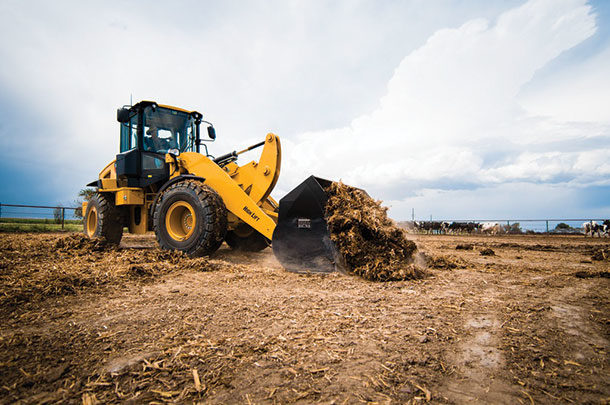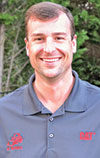However, despite the increased productivity small wheel loaders can bring to forage-growing operations, varying operational expenses like fuel prices and consumption continue to have an impact on operation profit margins.
Making informed decisions when purchasing new equipment is especially important to help owners combat the fluctuating operational expenses which can negatively impact overall profits. Fortunately, the latest top-tier models of small wheel loaders have been engineered to cut down on fuel consumption without sacrificing performance.
Additionally, new emissions technology and innovative machine-operating software systems are significantly helping owners lower their overall fuel costs and other operational expenses.
Fuel efficiency equals increased profit margins
Small wheel loaders with an intelligent hydrostatic power train allow operators to run the engine in one of two modes: standard or performance. In standard mode, the engine has a lower maximum speed of 1,600 rpm versus 2,300 rpm, which is the typical maximum speed of the engines most manufacturers install in their small wheel loaders.
Because of this, on average, the engine will burn 2.3 gallons of fuel per hour. Depending on the comparison, this technology can deliver up to 20 to 35 percent in fuel savings over conventional machines.
In performance mode, the maximum engine speed is 1,800 rpm – still significantly lower than most small wheel loaders. However, the engine power and hydraulic speed are boosted in all speed ranges. This optimizes machine capabilities for multi-function work and allows operators to get the job done faster while still saving fuel.
Small wheel loaders equipped with hydrostatic power train, low-speed and high-torque engines, and intelligent power-management technology can save up to 2,000 gallons of fuel a year. And less money spent on fuel quickly translates to increased profit margins.
Emissions technology: Maximize uptime and save money
The latest state-of-the-art emissions systems are not only reducing exhaust temperatures in an effort to minimize the risk of igniting flammable material but are also self-managing to reduce operational expenses. These systems utilize a clean emissions module designed to require no operator intervention or disruption of work cycles, which increases machine uptime while cutting fuel consumption and maintenance expenses.
With this technology, regeneration of the diesel particulate filter (DPF) occurs passively at a low temperature. Comparatively, some small wheel loaders have to stop every 500 hours and be parked in a safe zone to allow the system to carry out this task – a process that takes about 45 minutes.
Additionally, the emissions systems on most small wheel loaders require the DPF to be taken out and serviced by a dealer every 3,500 to 5,000 hours, which costs about $2,500 each time. With advanced systems, the DPF is designed to last the life of the engine without needing to be changed. This not only increases uptime but can also save operation owners up to $10,000 throughout the life of the machine.
With current Tier 4 emissions standards, if the valve lash gets out of adjustment, it can reduce the life of the DPF. Some manufacturers engineer their small wheel loaders with a mechanical lift system, which requires servicing every 2,000 hours to get the valve lash adjusted. Machines with hydraulic valve lash systems self-adjust, eliminating the need for regular service intervals.
Diesel exhaust fluid (DEF) maintenance can be especially delicate as DEF does not respond well to either extremely hot or cold conditions. While most small wheel loaders are equipped with DEF cooling systems, many require the engine to continue to run after the operator has shut down the machine in order for the system to cool the fluid.
However, the latest DEF cooling systems do not require the engine to keep running to properly cool the DEF after the operator turns off the machine, another feature that factors into overall fuel savings.
Advancements in machine-operating software
The operating display systems in small wheel loader cabs serve as a vital tool for owners and operators, not only for machine diagnostics but also for tracking fuel consumption. The latest secondary display systems have a four-quadrant screen which provides specific fuel-related details, including:
- Lifetime fuel burn provides the overall average gallon-per-hour fuel burn of the machine.
- Time until empty calculates how much longer the machine can run before it needs to be refueled. The system calculates this time based on how the machine is operating (i.e., standard mode versus performance mode or aggressive operation versus idling).
- Current fuel provides real-time calculations of the amount of fuel being used per hour while the machine is operating.
- Reset-able job clock allows the operator to track fuel usage per job per task.
While widely thought of as a safety and security feature, the latest coded start technology now allows operation owners to track fuel consumption and system diagnostics based on the operator codes. With this technology, owners can check for patterns of excess fuel burn by a certain operator.
If this is found, it presents an opportunity to implement training sessions or other initiatives to help the operator perform tasks utilizing more fuel-efficient settings. Coded start systems are also equipped with a master code, enabling owners to lock out certain features on the machine.
For instance, performance mode can be deactivated on the machine, in which case operators must complete tasks in fuel-saving standard mode.
Small wheel loaders have been crucial to forage growing operations for years, and with the latest fuel saving and operating technologies, they are significantly increasing productivity and profit margins. This is why it is absolutely essential for owners and operators to continually research the latest innovations and use this knowledge to purchase high-quality machines for their fleets. ![]()
PHOTO: Small wheel loaders have been crucial to forage growing operations for years, and with the latest fuel saving and operating technologies, they are significantly increasing productivity and profit margins. Photo courtesy of Steven Juricak.

-
Steven Juricak
- Small Wheel Loader Application and Engineering Specialist
- Caterpillar Inc.
- Email Steven Juricak












